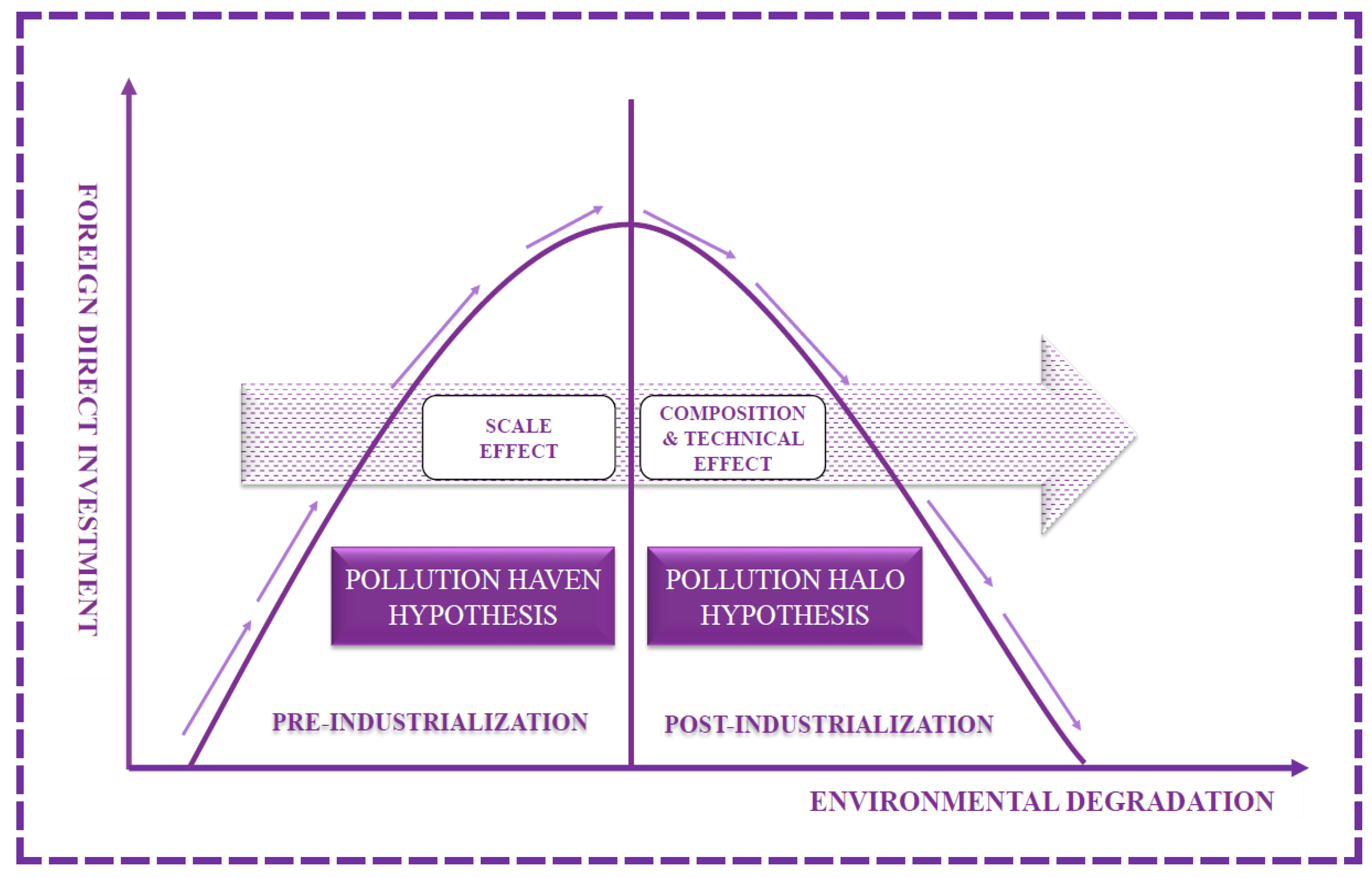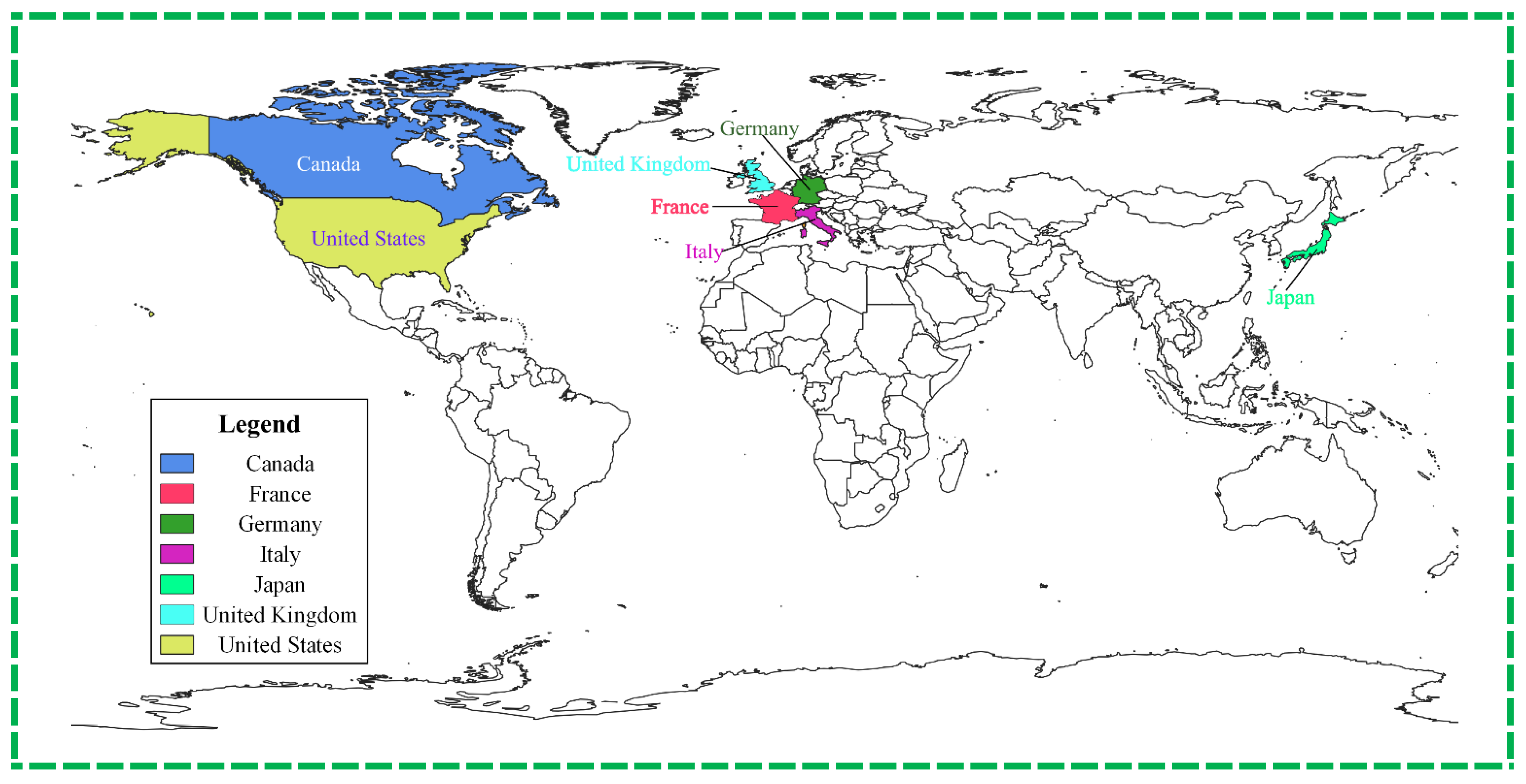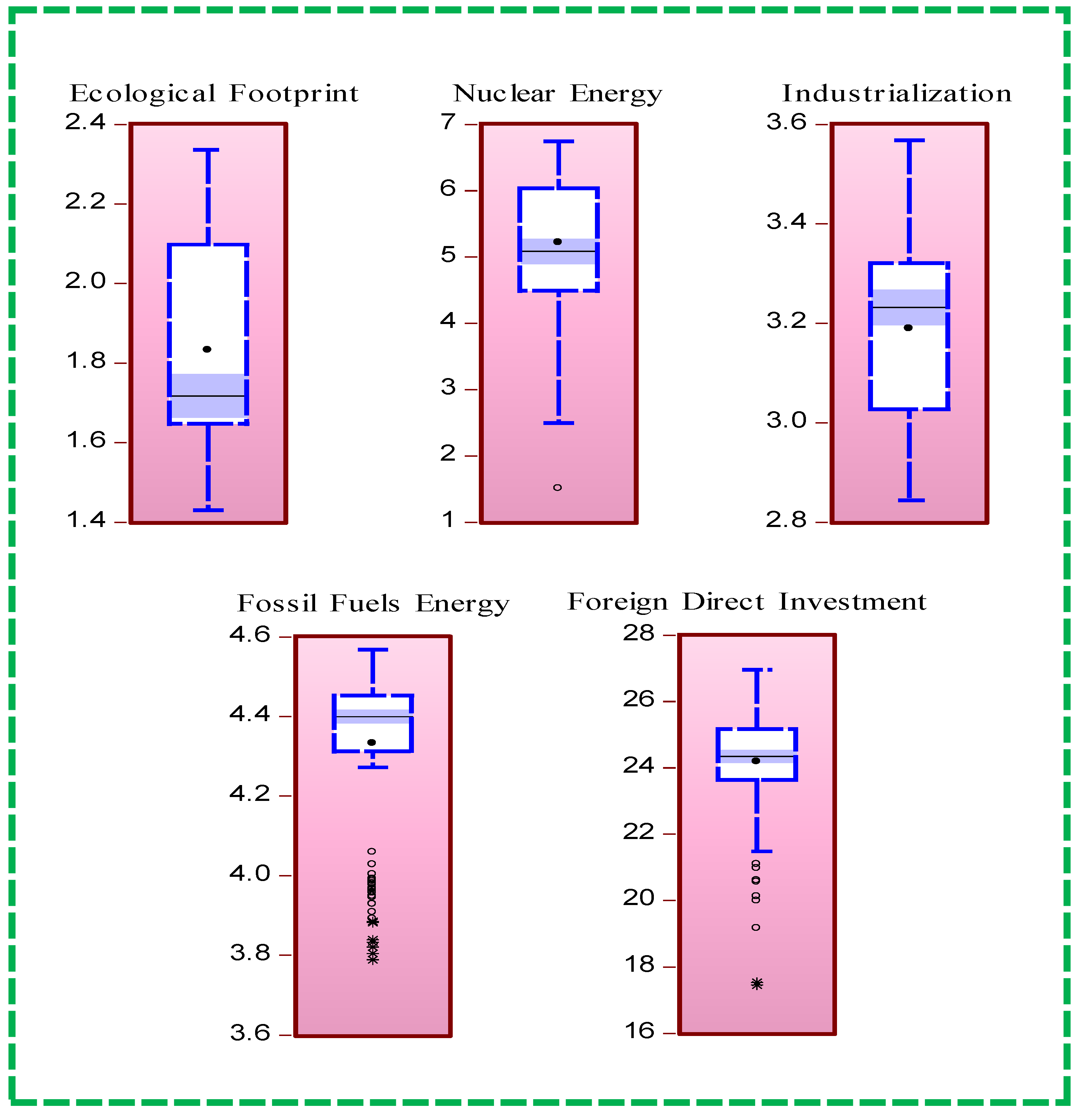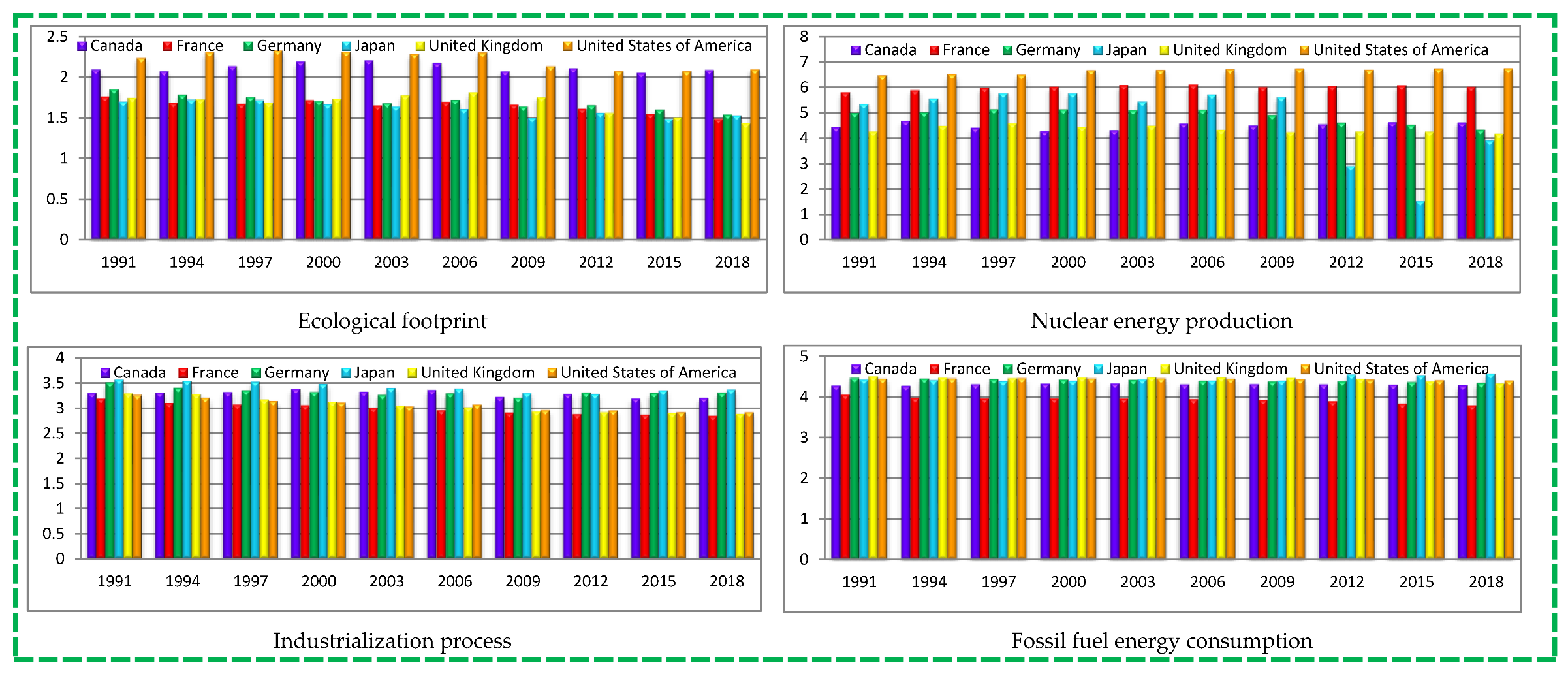1. Introduction
One of humanity’s biggest problems today is anthropogenic carbon dioxide (CO
2) emissions. Environmental pollution, ecological disruptions, global warming, and climate change are all results of human activities that emit CO
2. Most nations have recognized the detrimental effects of increasing atmospheric CO
2 levels and are taking action to prepare for dangers and extreme weather-related climate change [
1]. More than 60% of the world’s net wealth and approximately 50% of its GDP are held by G-7 nations: the United Kingdom, France, The United States, Canada, Italy, Japan, and Germany [
2]. This wealth could be traced to the rise in industrialization and technological advancement. Industrialization is crucial for sustained growth in any economy. These require enormous energy use, which without exception facilitates pollutant emission, igniting some policy concerns about the environment and economy [
3]. Within the last two decades, countries worldwide, predominantly industrialized, have made specific advancements in technology, innovations, human capital development, and productive sectors to attain sustainable economic growth. However, the emergence of industrialization, technological progress, and economic growth has posed severe concerns to the world, leading to climate change and global warming [
4,
5]. Furthermore, nuclear energy consumption is generally considered another type of non-renewable energy source. Even though nuclear power itself is an imperative source of alternative and renewable energy; however, the materials utilized in nuclear power plants are non-renewable energy based. This energy is unconfined in the course of nuclear fission; somewhere in the procedure, the atom splits the nucleus. In this regard, the substance frequently utilized in nuclear energy plants is the constituent of uranium. As such, uranium is observed as a non-renewable source. Besides, nuclear energy plants have various other influences on the atmosphere, with the exception of the waste they generate. Uranium mining is not absolute in an eco-friendly and carbon-free process, and it further unfastens pits enduring after mining, which is unsafe and hazardous for everyone. Consequently, this procedure leads to pollution in close proximity to water sources, erosion, affecting crops and plants; furthermore, it harshly distresses miners and their common physical condition owing to the increased exposure to radiation at some point in processing and extraction.
Industrialization, globalization, and economic development are the resultant effects of rising pollutant emission levels, such as CO
2 and greenhouse gas (GHG) emissions, amongst others within the atmosphere [
6]. While considering the growth of industries, especially among the top ten industrialized countries with their level of technology innovation, the energy sources used for the industrial process are regarded as severe policy issues for pollutant emission [
7]. Adedoyin et al. [
8] and Acheampong [
9] identified climate change and global warming as the “two evils” that have threatened the existence and survival of humans in recent times. However, the primary source of climate change and global warming has been linked to pollutant emissions, raising international concerns about reducing pollution emissions through programs and policies [
10]. Acheampong [
9] opines that over 5% of the GDP’s global contribution is a pollutant emission effect. If no action is taken, it will climb to 20% of global GDP, causing further environmental damage.
The rising use of fossil fuel energy resources as essential inputs necessary for extending the size of production of products and services for both domestic and international markets can be linked to their contribution to carbon emissions [
11]. The choice that puts the majority of policymakers in a quandary is around the trade-off between economic growth and a sustainable environment [
12]. These have led to a paradigm shift from fossil fuel to renewable sources as a pollution-reducing and environmentally benign option [
13]. Renewable energy adoption amongst G-7 countries will cause negligible environmental deterioration and is the most effective way to counteract global warming [
14]. One of the energy sources that stand out in this context is nuclear energy, whose role in preserving the environment’s quality has not been shown. There has been discussion of the benefits and setbacks of using nuclear energy. According to proponents, nuclear energy can be used to lessen reliance on foreign energy sources. Recent studies have shown that nuclear energy is less detrimental to carbon emissions than fossil fuel sources. In the first stand, some studies have agreed that nuclear energy plays a significant role in pollution minimization compared to renewable energy [
15,
16]. In the second research stand, some scholars have claimed that nuclear energy use is deteriorating the environment [
17].
Foreign direct investment significantly impacts the growth of developed economies, such as the G7, much as increased industrialization. Given its favorable effects on the provision of financial resources, technology spillovers, the development of human capital, research and development, international trade integration, market expansion, and economies of scale, among other things, FDI has been considered a key driver of economic growth among others [
18]. The pollution haven and halo hypothesis can be considered after recognizing foreign direct investment as a driving force for environmental damage. According to the pollution haven hypothesis, foreign nations may benefit from the severity of environmental rules and regulations in host nations by shifting heavy (dirty) industries to these nations through foreign direct investment, enhancing environmental contamination [
4]. On the other hand, the pollution halo hypothesis claims that the production structure of these international firms is generally based on eco-friendly technologies [
19,
20].
Figure 1 displays the typical inverted U-shaped association between FDI and environmental contamination, reflecting pollution halo and haven hypotheses.
The ecological footprint measures anthropogenic actions on the ocean, crop land, carbon footprint, grazing land, forest products, and built-up land, calculated in hectares of land worldwide (gha). The ecological footprint has been used in recent studies to gauge the impact of human activity on the environment. Over time, linking fossil fuel energy and ecological footprints have generated enormous debates [
22,
23,
24]. Where several productive activities in the economy bring economic growth as industrialization and foreign investment, which encourages fossil fuel extraction and its consumption and further worsens the environment by increasing its ecological footprint [
25].
This study investigates the role of industrialization, foreign direct investment, nuclear energy and fossil fuel in the G-7 countries. Four reasons motivated the choice of the G-7 countries. First, in terms of the economy, the G-7 accounts for approximately 57% of the world’s gross domestic product (GDP) [
26]. Second, the G-7 countries’ overall energy usage accounts for almost 42% of global energy consumption. Third, the Group of Seven has committed to supporting environmentally friendly technology and lowering waste created during the past 20 years through its annual conference [
27]. As a result, the G-7 countries have recorded a sizeable portion of global investments in research and development (R & D) and industrialization [
28]. Fourth, despite the progress toward achieving a green economy, the G-7 countries continue to face grave dangers from environmental pollution [
13].
This study represents the first attempt to determine the causal relationship between these variables because there has not been a thorough investigation of the subject that adequately handles entire G-7 nations, while considering other variables, such as industrialization, fossil fuel, nuclear energy, and foreign direct investment, and ecological footprint. The G-7 nations have long been attempting to address the problem of climate change and environmental contamination over the last couple of decades to upsurge their trade volume and sustainable economic growth. Furthermore, the impact of foreign direct investment (FDI) on environmental contamination is also scrutinized; thus, the validity of the pollution haven/halo hypothesis is also estimated. Moreover, complementary estimates from the fully modified ordinary least square (FMOLS), dynamic ordinary least square (DOLS), the Driscoll–Kraay method and feasible generalized least square (FGLS) approaches.
Hereafter, the other sections of this paper are organized into four sections in the following order: the literature review is presented in
Section 2, the data information and methodology specification are systematized in
Section 3, and
Section 4 presents the preliminary analysis, main results, and explanations. Furthermore,
Section 5 discusses the empirical finding of this paper and, finally,
Section 6 explores the conclusions.
2. Literature Review
The first strand reviews the existing published literature on the nexus between nuclear energy and the environment and has two different arguments. Some scholars have agreed that nuclear energy can help to mitigate environmental damages [
15,
29,
30,
31,
32]. In the second strand of existing literature, nuclear energy use deteriorates the environment quality evidenced by [
17,
33]. Some scholars argue that nuclear energy use does not influence the environment [
34,
35,
36]. Meanwhile, industrialization is an extensively used indicator of environmental contamination. Several authors argued that industrialization contributes to pollution [
4,
37,
38]. Several recent studies have scrutinized the association between renewable and nonrenewable energy use and environmental contamination. Many researchers argue that renewable energy mitigates environmental contamination, whereas nonrenewable energy boosts environmental pollution [
4,
39,
40]. Additional, FDI is another vital variable affecting environmental contamination. Nevertheless, the influence of FDI on environmental contamination varies. Some scholars observed that the association between FDI and environmental dilapidation is positive, thus supporting the pollution haven hypothesis [
40,
41,
42]. On the other side, some other researchers found that FDI adversely affects environmental dilapidation because FDI brings in advanced and eco-friendly technology. Based on the Table.1, we are developing the following hypothesis.
The study provides an inclusive review of a list of existing studies, such as the nexus between nuclear energy and the environment, the nexus between industrialization and environment, and the nexus between fossil fuel energy utilization and the environment and nexus between foreign direct investment and environment (as shown in
Table 1). Still, none of them have explored industrialization, fossil fuel, nuclear energy, foreign direct investment, and ecological footprint in the pollution haven hypothesis framework, especially in the context of G-7 nations. Hence, the primary purpose of our paper is to curtail the research gap in the extant literature.
5. Discussion and Policy Options
The G-7 countries are fossil-fuel-rich economies; nevertheless, the energy assortment diversification by including clean and alternative energy sources will encourage ecological sustainability and environmental quality, while diminishing their economy’s exposure to price instability. Considering the policy suggestions of the impact of nuclear energy, industrialization, fossil fuel energy, and FDI on environmental degradation, the current study recommends, first, a paradigm transition from fossil fuel-based energy and pollution-intensive industries to a service leaning growth that will affect a structural economic transformation, in consequence, supporting in the diminishing environmental pollution, climate variations, and its impacts. Second, The G-7 country’s policy of transparency and precision might be reviewed within a nuclear social effects investigation; consequently, the communication with the people and other stockholders can be deliberate in terms of participation in area selection, decision making, design criterion, nuclear awareness, and satisfaction, and so forth. Third, investment in cleaner energy has a viable advantage against nuclear and fossil fuel energy. For clean energy equipment to be eye-catching, it requires consumption policies that equally include renewable energy, technological expansion (innovations, technological advancement, research, and development, etc.), industry growth (e.g., affordable cost, higher performance, and superior quality), and also market progression (easily accessible and available markets). Fourth, the nuclear power position in renewable energy sources ought to be preserved. Nevertheless, it must be highlighted that constructive assistance of a power source to ecological eminence does not necessitate reliance on this source of energy. Each country of the G-7 panel should put into practice a resource diversification policy by assessing the efficiency of its power resources. As a replacement for being reliant on a solitary power source, governments and policymakers of G-7 countries should take action to diminish the environmental costs of all energy/power sources by escalating clean technological investments.
Furthermore, there is a dire requirement for technological development in the industrialization process and energy sectors that install developed technologies, for instance, carbon-free equipment, carbon storage, and capture, among others, in other to endorse energy competence. The permutation of legislation, policies, inspection, and standards associated with the accomplishment of novel technologies and enhanced social consciousness is constructive to limit environmental pollution that has the ability to encourage and advantage domestic countries by avoiding ailment and fatalities in the production process, guaranteeing a country’s environmental stability. The G-7 economies must encourage foreign and local investors to invest in renewable and alternative energy supplies and maintain apparent safety and security measures. Finally, while doing this, the government and all stakeholders must also spotlight endogenous growth of cleaner energy elucidations, with the intention that fossil fuel-based clarifications dependence might be terminated. At the same time, policymakers will promote the creation of new alternative and green jobs, which will construct full deployment of the green output procedures. Furthermore, foreign trade strategies might be redesigned to accommodate the energy revolution, and the foreign trade policies will be intended for increasing ecological excellence, such as the countries will be moved toward cleaner and green trade strategies. The surplus energy can be preserved and sold to other countries with elevated energy demand. By doing so, real revenue might increase. This surplus revenue can be committed to detecting cleaner and other new renewable energy foundations and expanding cleaner and more sophisticated technologies and green energy solutions. In this fashion, G-7 economies might be capable of facilitating accomplishment of the SDGs objectives by 2030.
6. Conclusions
Environmental pollution and global warming are considered one of the most severe issues faced by global economies due to an increase in carbon emissions as a consequence of nonrenewable and many other fossil fuel-based energy deployments. In addition, renewable energy resources’ role in mitigating environmental pollution has been a subject matter enduring concentrated studies in the existing literature. Considering this, the major aim of this research is to scrutinize the influence of nuclear energy production, industrialization, fossil fuel energy use, and FDI on ecological footprints from 1991 to 2018 in the G-7 countries. In view of that, it is one of the most vital issues in the development movement and cross-country cooperation in this era. On the whole, the econometric findings, controlling for cross-sectional dependency issue, explore that a 1% augmentation in the nuclear energy generation and fossil fuel power consumption will increase levels of ecological footprints in the long-run for G-7 economies by approximately 0.1109% and 0.3339%, respectively. Additionally, the industrialization process was also observed to display adverse roles in protecting environmental quality by 0.3351% in the region. Similarly, the empirical evidence shows that FDI also increases the pollution level by 0.0548% in the long-run.
Furthermore, the findings of the D–H causality test discover bidirectional causality between LNEP, LIND, LFDI, with LEFP, LIND and LNEP, between LIND, and LFFE, and between LNEP and LFFE, and finally, between LIND and LFFE in this study. In addition, a unidirectional causality exists from LEFP to LFFE, from LFDI to LNEP, and from LFDI to LIND. As a result, the findings based on the present study enforce some key policy suggestions for the policymakers and central authorities in the G-7 economies and assist these nations in achieving low-ecological footprint growth all the way through the adoption of renewable energy use and carbon-free technologies for a sustainable environment.
The major limitation of this research is the small panel data set dimension applied owing to the unavailability of the relevant variables. Additionally, upcoming studies could widen this research by the ecological influences related to high shares of nuclear energy deployment in the overall energy mix volume of these G-7 economies. The possible research trends can be anticipated to facilitate the G-7 and some other world-polluted energy-intensive countries to ascertain the suitable pathways leading to a sustainable environment, particularly through the renewable energy evolution channel. Moreover, innovative and alternative environmental indicators can also be taken to approximate the functions to test for the results robustness across substitute environmental proxies in the G-7 economies. Besides, future studies could incorporate some other macroeconomic (environmental related) regressors, for instance, (renewable energy, total factor productivity, environmental-related technologies, economic complexity, agricultural productivity, export product diversification, energy innovations, aging factor, and human capital) and a large data set could make upcoming studies more reliable and attractive in tackling the SDGs.


















